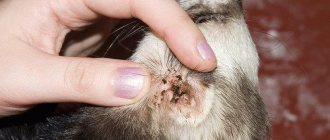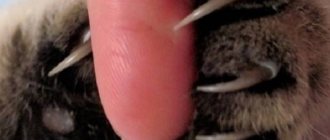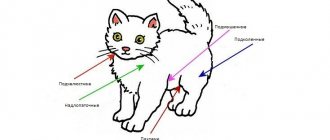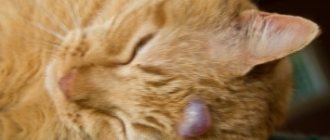If a kitten, having settled into a new apartment, does not pay attention to rustling pieces of paper, does not react to the sound of an opening refrigerator or a running vacuum cleaner, and, closing its eyes, instantly falls asleep, most likely the kitten was born deaf. It happens that a kitten born deaf returns to hearing by the end of the first year of life.
It happens that cats are born deaf.
This congenital defect should not be confused with deafness and blindness in newborn kittens - both resolve over time. Because of their superior vision, deaf cats usually learn to navigate well without hearing. It is sometimes possible to notice such a deficiency only through careful observation. Keep in mind, however, that keeping a deaf cat indoors is more difficult, and outdoors it is bound to get hit by a car or bicycle.
Some white cats are born deaf (an inherited trait related to the color of their fur), and older cats sometimes become deaf as they age, but their other senses allow them to lead quite normal lives.
Like deaf people, deaf cats learn to “listen” with their feet, feeling vibrations with their paws that we sighted people don’t notice.
Most often, deaf kittens are born from the mating of two white cats, or rather albino cats, when the four-legged cat has white not only fur, but also whiskers. Moreover, if kittens have at least slight darkening of the fur on their heads, even without clear outlines, this is a 100% indicator that the animal will not be deaf. If such a spot is not observed in a kitten under 10 months of age, it should be shown to a specialist. Keep in mind that according to statistics, among white cats, only 10-20 percent of kittens are born deaf.
In white cats, deafness occurs quite often, and both a blue-eyed animal (most often), and a different-eyed one (less often), and a yellow-eyed animal (even less often) can be deaf. If your cat really has hearing loss, and this is genetically determined, then nothing can be done. For a domestic cat, this is not so scary - deprived of hearing since childhood, it quite normally adapts to using other senses, and, unlike a person, it does not feel different from others or any “deficiency”.
A cat's hearing loss can be caused by infectious diseases or damage to the eardrum. Hearing is very important for a cat, as it helps determine the distance and direction to the source of noise. Deaf cats, however, can lead almost normal lives, but they need help during the adaptation period.
Treatment of deafness in cats.
If deafness is caused by poisoning with toxic substances, is age-related or hereditary, it cannot be cured. You must help your cat adapt to life without hearing. Because the cat gets scared easily without hearing people approaching. Try not to make sudden movements or appear unexpectedly in front of the cat, if possible, somehow warn the cat. For example, turn the light on and off or stomp on the floor so that the cat feels the vibration. You may also notice that your cat is able to learn to follow your gestures and even read your lips. Try to always give commands in the same words and so that the cat can see your lips, and then show what she should do. You will be surprised how quickly your cat will understand what is required of her.
A cat can adapt to deafness, so be aware that it will require more attention and support.
Probably those who had white cats noticed that they had hearing problems. Why does this happen and how can you check how deaf a cat is?
How to sober up quickly in the morning
You can save yourself from the painful symptoms of a hangover if you take some measures in the evening to quickly sober up in the morning.
- After a feast accompanied by heavy drinking, you need to do a gastric lavage. To do this, upon returning home, you should drink as much water as possible and induce artificial vomiting.
- After this, you need to take sorbents: activated carbon, polysorb, enterosgel. Sorbents can be taken before or during a feast.
- If there is strong alcohol on the table, do not forget about a snack to neutralize the effects of alcohol. It is best to eat a large meal before drinking alcohol.
- In the morning, take the sorbents again. Let us remind you that activated carbon is taken at the rate of 1 tablet per 10 kg of weight, other medications are taken as prescribed.
- A light breakfast is recommended - porridge, fermented milk products, sweet tea.
- A cool or contrast shower will improve the condition.
- Don't forget about water: a large amount of liquid will help remove alcohol from the body and quickly sober up.
If you control the amount you drink the day before and follow some simple tips, you can save yourself from the symptoms of a severe hangover.
However, if nothing helps, then the advice is this: call the clinic and have a doctor come to your home, he will help you sober up quickly and safely in a short time.
Click here to view the conditions, tariffs and prices for treatment
Why are white cats deaf?
Deafness in white cats is explained by certain genetic characteristics. The white color gene, which is dominant, specifically affects the processes that occur in a small organism at the stage of embryonic development, and it also affects the development of hearing. This has been proven through numerous experiments.
If the kitten had representatives or Thais in the family, then the presence of blue eyes does not fully guarantee that the grown cat will be deaf. This is explained by the fact that the gene with this pathology was taken from Siamese cats that do not have this problem.
Kittens of many breeds are born with blue eyes, but their color later changes. Therefore, when you see a blue-eyed white kitten, do not be alarmed: it is not a fact that he will remain with that eye color and will not hear. Wait a little, let him grow up, and everything will fall into place.
People who decide to have a white kitten need to know all the nuances associated with the peculiarities of its development. Not all kittens are equally deaf. Before buying a new family member, you should find out what type of hearing he or she has already at the stage of selecting an applicant. After all, it may well be that not everyone is able to provide a normal life for a deaf child and teach him to understand a person.
Deafness can be temporary or permanent. It usually occurs due to age, a genetic defect, infection, mites, injury, or as a side effect of certain medications. Deafness in cats can be either in one or two ears, partial or complete. The problem may be due to the ear itself or due to the inability of the brain to process information.
In what cases can hearing be restored?
A deaf cat is usually overly fearful and often flinches for no good reason.
If deafness is caused by any disease, well-chosen therapy makes it possible to restore hearing functions by 100%. Based on the examination, the veterinarian prescribes antibiotics for infections, insecticides for parasites, or chemical therapy (in combination with radiation) for tumors.
If hearing loss occurs as a result of severe intoxication, is of a hereditary nature, or is associated with the animal’s advanced age, it cannot be cured.
Ear infections, mites and allergies
Ticks can damage the eardrum. Ear mites are a very common disease in cats. Be careful. If a cat scratches its ears and behaves restlessly, it is worth examining it. If you see redness, swelling or a black sticky substance in your ear, this is an alarm, contact your veterinarian immediately. Although these signs may not only indicate the presence of ear mites, they may also indicate the presence of an ear infection.
Food allergies can cause ear infections. If your cat develops an allergy, change the food and contact your veterinarian.
Let's look at some practical tips:
- If your cat sleeps on the floor, then stomp more powerfully so that the floor vibrates, then the cat will feel the approach.
- If your cat sleeps on the bed, rock the edge of the bed to wake your cat.
- If you have a lot of guests, leave the cat indoors.
- Try to provoke a reaction from the cat in any way: vibration, gestures, touch.
- Never leave a deaf cat outside.
- Give your cat a bell and you will always find it in your apartment.
Methods of sobering up in an inpatient drug treatment clinic
Above we have listed several physical and medicinal methods for quickly sobering up. However, it often happens that the measures taken did not lead to the desired result, then the best decision is to seek help from narcologists.
The clinic will help you quickly recover through effective and reliable therapy - detoxification drips. Also, ethanol and its breakdown products are removed from the body with the help of medications. Fast, guaranteed and safe sobering up is impossible by other means.
Be sure to consult a doctor if a drunk person:
- does not come to consciousness for a long time;
- experiences severe headaches;
- complains of breathing problems, pain in the stomach, chest area;
- has chronic gastrointestinal diseases;
- experiences physical suffering;
- becomes aggressive or hallucinates.
These signs indicate that you cannot do without specialists. Unfortunately, severe withdrawal is fraught with serious complications: heart attack, stroke, perforated ulcer, and if some factors coincide, an irreversible outcome is possible. Don't risk your health!
Adopt your deaf cat
A deaf cat is a problem, but no more than a healthy cat that doesn't respond to its name. Cats are very flexible animals and can compensate for hearing loss by using other senses. The main thing to remember is that a cat needs love, both deaf and healthy.
An animal, like a person, experiences the world around it with the help of five basic senses. The ears, which carry out the function of hearing, are the second most important organ of information perception after vision. For cats (especially those who lead an outdoor lifestyle), the importance of this organ cannot be overestimated. Thanks to him, the animal knows how to navigate, recognizes impending danger and gets food for itself.
Hearing loss for a wild cat is tragic. This makes her completely defenseless. But this is not the case for a pet. For her, deafness is not a tragedy. It only changes the animal’s usual way of life, forcing it to adapt to new conditions. If we take into account the good adaptive qualities of a cat, then with some attention and help from a caring owner, the quality of life of a deaf animal can be quite high. Our article will tell you about the types of congenital and acquired deafness, how hearing loss is determined and what to do if your cat is deaf.
Depending on the origin, deafness in cats can be congenital or acquired.
Congenital deafness can have two causes:
- pathologies of intrauterine development of the fetus, leading to disruption of conductivity or perception of sounds in the structures of the hearing organ;
- aggravated heredity - the presence of the white coat color gene W.
Acquired hearing loss that develops into deafness can be acute or chronic.
- acute deafness occurs suddenly, symptoms increase rapidly over a short period of time;
- Chronic deafness develops gradually over many months or even years. A distinction is made between stable and progressive deafness.
Many owners know the fact that white cats with blue eyes often have a congenital defect such as deafness. Such cats have a special dominant W gene in their genotype. It is the presence of this gene that makes the likelihood that a white cat will be deaf very high. In some cases it reaches 80%. In turn, congenital deafness in individuals of a different color is an extremely rare phenomenon.
The dominant W gene is pleiotropic, that is, it is responsible for the presence of several traits at once. In addition to white coat color and deafness, it also makes blue eye color dominant. The probability of deafness among white individuals is distributed as follows:
- animals with blue eyes are deaf in 80% of cases;
- animals with heterochromic eyes (one eye is blue and the other is a different color) are deaf in 40% of cases;
- animals with eyes of any color (except blue) are deaf in 20% of cases.
It has been noted that deafness in white cats, caused by the presence of this gene, can be either unilateral or bilateral (long-haired beauties most often suffer from it).
How does deafness develop in white individuals?
It is known that absolutely all kittens are born deaf, with closed ear canals. By the age of 5-7 days they gradually open. At the age of two weeks, the kitten is able to determine the direction of a sound, and by a month, it can already distinguish sounds. In a white kitten, due to genetic disorders, by the time the ears open (at a week of age), the organ of Corti, the receptor part of the auditory analyzer, located in the auditory labyrinth and responsible for analyzing sound signals, atrophies.
Features of natural and artificial selection of white cats
In the wild, white cats survive much less often than others, since they turn out to be much less adapted to the unfavorable factors of the surrounding reality. The reasons for this are as follows:
- high probability of deafness;
- photophobia, which is promoted by a light shade of the eyes;
- poor vision in low light conditions.
In conditions of artificial breeding, white cats are very popular because they have an attractive appearance. They are actively bred, despite the high likelihood of physical defects.
STEPS FOR A HEARING EXAMINATION BY A VETERINARIAN
- Your veterinarian should start by examining your cat's ear canal . This way you will ensure that it is clean and undamaged.
- To determine whether your cat is deaf or not, you can perform simple sound tests by simply playing a loud sound near the cat, but outside its field of vision. A specific response from a cat is sought as the movement of the ears towards the source of the sound. It is important to make sure that the air does not move causing the sound because it may also attract the cat's attention. However, this test does not provide a definitive diagnosis.
- In order for your veterinarian to give you an accurate and reliable diagnosis, it is necessary to turn to electrodiagnostics . This is the definitive way to know if your cat is deaf. These tests are indicated from the sixth week of a kitten's life, when the auditory system is more mature. Electrodiagnostic tests are based on the detection of electrical activity generated by the cat's nervous system , either spontaneous or auditory stimulation. Additionally, because a cat's skin is not a good conductor of electricity—because it has a lot of hair—this test requires the use of needle electrodes .
As you have been able to check, it is very important to get a correct diagnosis to determine if your cat is deaf. Although you may observe certain signs in your cat, you can only be 100% sure that your cat is deaf if your veterinarian makes an appropriate assessment using objective methods. In case your cat is deaf, you should think very carefully whether you should allow her to breed , especially if her deafness is due to genetic factors. In this case, preventing the breeding of animals with deafness is in our hands, and it would be enough to sterilize your kitten.
Source
Treatment of the disease
Treatment methods for deafness vary depending on the causes that cause it:
We can say that congenital deafness is not a pathology, but a feature of the white color. Since the animal is born deaf, it does not adapt, but lives, from birth actively including the other senses (vision, touch and smell). Therefore, caring for such kittens is practically no different from caring for their healthy counterparts.
White cats are extremely popular among cat lovers, so they are bred despite the risks. But this process should be controlled by an experienced breeder. Errors in the selection of pairs threaten that deafness, as a genetic trait, may manifest itself in the offspring. In addition, there is a high probability that sickly and non-viable offspring will be obtained.
There are several specific features of keeping deaf pets:
- One of the main conditions is that such cats should not be allowed to go outside alone, as they are more exposed to various dangers than others.
- You should not approach the cat from behind, so as not to scare it. As a last resort, when entering, you can slam the door louder or stomp, creating vibrations that are clearly felt by the animal.
- They can read lips, so it is necessary to address her in such a way that she sees the owner’s face.
- You need to be extremely careful when being in the same room with a deaf pet so as not to step on it.
Deafness is not a reason to throw your furry pet out onto the street or euthanize it. With careful attention, love and care, this deficiency will not be noticeable to either the owner or his pet.
TESTING METHODS IF YOUR CAT IS DEAF
We're not going to lie to you, this task can be very difficult , especially if your cat has been deaf since birth and has managed to adapt to this condition by heightening other senses.
However, if you look carefully, you may find signs that your cat has deafness, or at least an injury to the ear that reduces her ability to hear. Essence:
- She doesn't come when you call her and doesn't pay attention to loud noises. You can try slamming, slamming a door, or turning on a vacuum cleaner near her—cats usually perceive this as an unpleasant sound, and if she hears it, she will run away.
- sometimes appears disoriented and shakes her head frequently. You may even notice discharge from your ear.
- She displays a much louder meow since she cannot hear it.
- She becomes nervous and tense, and her behavior begins to become suspicious.
These signs prevent you from making a diagnosis at your own risk. If you want to be on the safe side, you should contact your trusted veterinarian to have your cat clinically evaluated.
How to determine deafness in cats and what to do about it
An animal, like a person, experiences the world around it with the help of five basic senses. The ears, which carry out the function of hearing, are the second most important organ of information perception after vision. For cats (especially those who lead an outdoor lifestyle), the importance of this organ cannot be overestimated. Thanks to him, the animal knows how to navigate, recognizes impending danger and gets food for itself.
Hearing loss for a wild cat is tragic. This makes her completely defenseless. But this is not the case for a pet. For her, deafness is not a tragedy. It only changes the animal’s usual way of life, forcing it to adapt to new conditions. If we take into account the good adaptive qualities of a cat, then with some attention and help from a caring owner, the quality of life of a deaf animal can be quite high. Our article will tell you about the types of congenital and acquired deafness, how hearing loss is determined and what to do if your cat is deaf.
Types of deafness by level of damage
- Conductive hearing loss is acquired. A pathological obstruction occurs in the path of sound transmission or amplification in the ear. This disorder can occur at the level of the outer ear (this includes malformations, cerumen plugs, otitis or neoplasms, ear parasites) or the middle ear (injuries and malformations of the eardrum, otitis media, otosclerosis). If the disease that caused the pathology is curable, then this type of deafness is reversible.
- Sensorineural deafness is often congenital. Most often, this is a pathology of the inner ear, which is a damage to the sensors - the hair cells of the inner ear. With their help, mechanical vibrations are converted into electrical impulses. This also includes pathologies of the auditory nerve. The perception of sound with this type of deafness is distorted or disappears completely. When the disease is acquired, its cause is often infectious diseases (meningitis, encephalitis), autoimmune diseases (Wegener's granulomatosis), as well as microcirculatory disorders in the inner ear, Mernier's disease.
- Central deafness occurs due to severe pathologies of the central nervous system and brain in cats. Its percentage in the total number of cases of deafness is small.
- Age-related deafness is a consequence of degenerative processes in the body of an animal on the verge of old age. The disease begins with the appearance of senile hearing loss in older individuals. It is slowly progressive and irreversible, and finally gives way to complete deafness.
Prevention and care of the ears: how to prevent the development of deafness
High-quality ear prevention and care will help the owner preserve the pet’s hearing.
You don’t have to do anything particularly complicated for this:
- It is necessary to examine the inside of the ears and the external auditory canal approximately once a week. If sulfur begins to accumulate there, it must be removed. To do this, use ordinary cotton swabs moistened with sterile vegetable or petroleum jelly. At worst, even saline solution (also sterile) will do. All liquids must be heated to approximately 37° Celsius before use.
- If a cat constantly scratches and scratches its ears, and abundant brown deposits are easily visible on the pinnas and in the ear canals themselves, you should immediately treat your pet for otodectosis (ear mites). These parasites often cause severe allergic reactions and, in advanced cases, contribute to the development of severe otitis media. Before using ear drops, you should also carefully remove mite waste in the same way as with regular ear cleaning.
- In long-haired cats, excess hair around the ears should be trimmed periodically. This promotes better ventilation of the ear canals, which prevents the creation of favorable conditions for parasites and pathogenic fungi.
Causes of acquired deafness
The most common causes of acquired deafness are:
- Traumatic damage to the integrity of the eardrum. These are caused by falls from heights, blows, inept ear cleaning or acoustic trauma.
- Complications of infectious diseases. With advanced otitis media, the internal structures of the ear are involved in the inflammatory process, and the pet may become deaf. If the disease progresses and is complicated by purulent inflammation affecting the meninges, there will be a real threat to the animal’s life.
- Tumors of the ear structures or parts of the brain responsible for hearing function are the most difficult in terms of treatment and prognosis. Irreversible changes may occur.
- Ear parasites cause temporary hearing loss. Severe itching leads to severe scratching and injury to the outer ear structures. Competent and timely treatment can completely correct the situation.
- Ear plugs are a consequence of poor hygiene. Your cat's ears should be cleaned regularly to remove any wax that has accumulated there. Increased sulfur production is usually evidence of a malfunction of the excretory system.
- Age-related deafness in older cats is an inevitable symptom that is a sign of degenerative changes in the auditory nerve or structures of the inner ear.
TYPES OF DEAFNESS AND CAUSES
If your cat is deaf—in scientific terms—she will lose the ability to hear or have difficulty hearing normally. Hearing loss can affect one or both ears and can be complete or partial, progressive or sudden, temporary or permanent.
There are different types of deafness in cats:
- Transmission deafness: These are associated with ear diseases or blockages in the outer or middle ear caused by tumors, infections, accumulation of earwax or mites, etc. In these conditions, sound waves cannot reach the inner ear and the consequence of this is that your cat deaf. To reverse this process, there are medical or surgical procedures that usually have good results.
- Perceptual deafness: In this case, damage is found in the inner ear or even the auditory nerve. This damage can be caused by genetic changes such as the W gene in white cats with blue eyes, inner ear infections, toxicity from certain medications, trauma, or degeneration common in very old cats.
- Mixed deafness: There may be cases where transmission and perception factors coexist.
Genetic causes of deafness in cats
Elderly pets partially or completely lose their hearing due to degenerative processes and atrophy of nerve endings. Most often, the process of hearing loss is irreversible, but against the background of decreased activity, animals adapt well to deafness. Teach your cat in advance basic gestures that will help you communicate with a deaf cat with age-related hearing loss. If your cat has become deaf from old age, she needs to provide appropriate living conditions and minimize the need to take care of her own safety:
- Isolate the animal from the street.
- Buy a collar with a bell so you can find your pet if he is hiding.
- Always say hello, goodbye and encourage your pet tactilely.
- Do not appear suddenly, wait until the pet sees you or create a vibration that the cat will feel, for example, by stomping on the floor.
Congenital deafness in cats is not necessarily associated with color or heredity. Any disturbances in the development of fetuses during the 1st week of pregnancy can lead to atrophy of auditory receptors. The causes of degenerative processes in the development of fetuses are most often associated with disruption of the nervous system of a pregnant cat - intoxication, acute viral and infectious diseases.
Are all white cats deaf? - No, not all. Are all blue-eyed cats deaf? - Again - no! The “stigma” about the deafness of white cats has certain grounds if the animal’s family included Angora cats, which have a risk of gene damage, as a result, improper formation of the inner ear. And again, not all Angora cats are deaf; if the kitten is purchased from responsible breeders, it has documents confirming the absence of genetic “gaps” in both parents.
White cats with blue eyes or heterochromic irises (eyes of different colors) are also carriers of Angora blood. It has been established that in cats with different irises, deafness is observed in the ear that is on the same side as the blue eye. The ears of newborn kittens are covered with a film and an outer leathery membrane. In Angora “heirs” with a mutated gene, by the time their ears open, the organ of Corti (receptors responsible for the perception of sounds) atrophies. That is, the kitten is not born deaf, but the pathology develops in 10–14 days.
Traditional methods of sobering up
If you urgently need to sober up, you can also use folk remedies, although not all of them are good for achieving the desired effect.
The most effective, but short-term method that can cope even with fainting is to sniff ammonia. However, the adrenaline rush neutralizes the negative effects of ethanol for a very short time. This method is good if a person has fallen asleep and there is no way to wake him up. Or you need to instantly cheer up for further action.
However, there are also really useful folk remedies that promote rapid sobering up. For example, herbal decoctions, natural honey, cabbage brine restore the water-salt balance and saturate the body with vitamins. Viscous porridges normalize the functioning of the gastrointestinal tract and prevent the absorption of alcohol into the blood. Fiber-rich foods cleanse the intestines of toxins. Fermented milk products (kefir, tan, ayran) restore microflora. Massage of the earlobes and feet activates the nerve endings, which also contributes to sobering up.
A few words about breeding white cats
The claim that white kittens are deaf is based on ignorance. There are a number of arguments that prohibit mating of certain individuals. There is no white color in nature; it is a certain mixture of the basic spectrum that produces white radiation when reflected. When talking about white cats, we mean:
- Albinos (lack of pigmentation due to gene mutation) – white (transparent) coat, white-blue, pale blue, white iris.
- Individuals with the “white spot factor” - visually, the cat looks white, but the color consists of tightly adjacent spots.
- Individuals with a dominant white gene are the so-called deaf cat breed in which the genes for all coat and iris colors are suppressed, except for white and bright blue, respectively.
Not all white cats are allowed for exhibitions and breeding. It is strictly forbidden to breed a deaf cat if the disease is caused by genetic disorders. Also, most clubs prohibit white-on-white mating, regardless of iris color, pedigree, physical health and other factors.
Signs of acquired deafness in cats
Gradually progressive deafness in cats is compensated by the sense of touch and smell, which complicates the diagnosis of the disease in the early stages. Even if a pet has 10% hearing, it does not appear deaf. Symptoms indicating complete hearing loss are:
- The cat doesn't hear voices. Sometimes, pets completely ignore their owners, which is mistaken for deafness.
- Visually, timidity and uncertainty are noticeable; the animal often turns around. Typically, cats turn only their ears to “assess” their environment.
- The animal meows unnaturally loudly.
- There is discomfort - the cat shakes its head and scratches its ears.
- As infections develop, there may be an unpleasant odor from the ears and the release of exudate.
- When frightened, the animal prefers to shrink and remain in place.
There is a method to test a cat for deafness. You need to position yourself so that your pet doesn’t see you and knock on any surface. A different range of sounds is produced alternately, from a dull blow to a sharp one, from quiet to loud. At the same time, the cat turns its ears to a quiet sound, and its head to a loud sound. In kittens up to 3–4 weeks of age, deafness is almost invisible; the only sign is a weak “copying” of the behavior of hearing babies.
Important! A cat's whiskers allow you to feel the slightest vibration in the air; during a hearing test, monitor the amplitude of your movements to avoid getting a false result.
Deafness as a consequence of illness
Acquired hearing problems occur due to illness or injury. Changes can be reversible only with timely diagnosis and treatment. Do not self-medicate, contact a veterinarian who, based on experience, will narrow the “diagnostic circle” and tell you what to do first. Common ailments that cause hearing loss include:
- Otitis is an infection of the ear canal. An infection that has entered the cavity of the inner ear causes inflammation and, in progress, the formation of pus. Acute otitis media is a very painful disease that leads to partial or complete hearing loss. Without treatment, the animal dies from complications in the form of an inflammatory process in the brain.
- Earwax – due to a malfunction of the excretory system, the ear canals become clogged with a dense brown mass. To determine how to treat the patient, the discharge is analyzed to identify the root cause of the deviation; there are two “typical” options - a “bouquet” of impaired metabolism, worm damage and weak immunity, or ear mite damage.
Deafness in cats: basic information
All types of deafness (regardless of their etiology) can be divided into two large groups:
- Primary (most often it is congenital). In these cases, hearing loss develops “on its own,” most often due to some genetic reasons, the animal’s initial predisposition to this pathology.
- Secondary. In practice it is most common (with the exception of some breeds suffering from the primary variety). It is a consequence of hundreds of different diseases that in one way or another affect the condition of the animal’s hearing organs. This includes both “simple” injuries and neurological pathologies (including especially “successful” attacks of epilepsy).
Signs of cat deafness
Anyone who has had or has a cat at home knows how “sensitively” pets react to the sound of the refrigerator opening or the rustling of a bag of cat food being opened. All this immediately refutes the opinion of many owners about the inherently poor hearing in cats: yes, eyes are important for them, but nocturnal predators (which include many cats) also need hearing.
Accordingly, if it sharply worsens or is absent, symptoms will develop immediately:
- The animal immediately stops responding to various sounds. The cat will sit calmly in the next room, as if nothing unusual is happening, even though before it would have rushed headlong towards the food source.
- The pet itself begins to behave strangely. This is due to the fact that hearing for cats is not a primary sense, but it is far from useless. The animal becomes more apathetic and tries to get out of its favorite resting places less often. Moreover, many cats are frankly afraid to go outside, even if they used to be desperate “revelers.” This is due to the fact that they cannot adequately identify sources of threats, and therefore tend to avoid excessively close contacts with the external environment.
- The cat becomes extremely shy. Any person who has had a cat at least once in his life knows how difficult it is to take a waking pet by surprise. But in cases where the pet is deaf, this is easy to do. But it’s not very safe: cats become so nervous that they can suddenly rush to the side, or even scratch the “impudent” one out of fear.
How to check for deafness?
Let us immediately emphasize that all methods suitable for use at home do not fall into the category of particularly accurate: they can only indirectly indicate deafness or its absence, and therefore the final diagnosis can only be made based on the results of a clinical examination of the animal. So how can you check if a cat is deaf or if his hearing is okay?
Here's what you can do:
- Carefully approach the cat and clap your hands sharply. But! This must be done carefully. If the pet is not deaf, there is a chance to suffer from the consequences of his “hysterical” jumping around the house.
- Since deaf pets are highly susceptible to various vibrations, you can try to attract the cat's attention by knocking on the floor. If the cat can hear, she will know perfectly well what exactly the owner is doing, which will be noticeable by the twitching of her ears. This sign is not observed in deaf pets. On the contrary, deaf and hard of hearing cats will react sharply, and sometimes even inappropriately, to floor vibrations. They don’t understand what it is and what causes it, and therefore they are very nervous.
How to check if a cat can hear
At home, you can independently test your animal for hearing loss. To do this, it is enough to make a sharp loud sound. A healthy cat will certainly turn around and give a reaction. A deaf cat will not react to a stimulus. To be sure, the animal should not see you; if your hearing is impaired, cats may react not to noise, but to your hand movements or vibrations in the air. The reliability of this method is 95%. If the situation for the cat is very familiar, he sleeps soundly and does not have a fearful disposition, then the faucet may be reluctant to respond to the sound.
You can only get accurate information about whether your pet is deaf at a veterinary clinic. And even then not in every one. To date, a medical test has been developed, which is carried out using special equipment. During its implementation, the frequency and intensity of nerve impulses in the brain that appear as a result of sound exposure are measured. In cats that cannot hear noise, such impulses are completely absent, which proves the presence of deafness. Diagnosis is carried out very rarely; owners often determine the lack of hearing in cats at home quite accurately.
Main causes of feline deafness
As we have already written, the reasons for the disappearance or significant weakening of hearing are very diverse, but we will describe the most important ones.
Deafness after otitis media: why is this phenomenon dangerous?
Perhaps, complete or partial loss of hearing after otitis media, i.e. inflammatory process in the inner ear is one of the most common phenomena in veterinary otolaryngology. This is due to the fact that not all owners understand the potential danger of this pathology.
Important! If purulent inflammation develops in the cavity of the inner ear, accompanied by the release of pus, nothing good will come of it.
Pus is a powerful natural “solvent” that can damage and liquefy not only soft tissue, but even bones. Accordingly, after prolonged otitis media, the likelihood of hearing deterioration is extremely high.
Accordingly, it is not difficult to guess about the potential danger of this phenomenon: the hearing organs are located in close proximity to the brain. In addition, there are many blood vessels there.
If otitis media is not treated at all, deafness can become the cat’s smallest problem. He may well die from brain damage, sepsis or similar causes.
Senile hearing loss in cats
With age, pets (and pet owners) do not become healthier. In particular, the blood supply to the tissues in the hearing organs deteriorates, the eardrum becomes “flabby,” and other negative changes accumulate. Senile hearing loss occurs. Alas, nothing can be done about it; old age will take its toll in any case.
Considering that cats are animals with a fairly decent lifespan (subject to normal maintenance and feeding), their hearing begins to deteriorate no earlier than ten years of age. It happens that pets who live to be 14 or more years old hear almost nothing. True, this is not their most serious problem: by this time cats often go blind.
Congenital deafness in cats, its breed variations
The most problematic may be congenital deafness. The following negative environmental factors (as well as their combination) often lead to its development:
- Parasitic diseases of the mother. Worm pathologies in pregnant cats are extremely dangerous. It's a matter of migrating parasite larvae. They extremely easily overcome the placental barrier, penetrating the body of unborn kittens. Since young parasites do not choose their “entry point,” they can end up anywhere. In the brain, for example. So in this case, deafness can be perhaps the smallest problem.
- Uncontrolled use of various medications is very dangerous. A classic example is the “heavy” old antibiotics from the group of penicillins and tetracyclines. They are prescribed to cats only in the most exceptional, emergency cases. If such a medicine is used when the cat is already pregnant, her kittens may well become deaf. Moreover, there is a considerable risk that the mother herself will become deaf.
- Various poisonings can result in a similar outcome. For unborn kittens, toxins are extremely dangerous: they interfere with the process of normal laying and formation of organ systems.
But still, the real “leaders” in the issue of congenital hearing loss are some breeds, some of which we will talk about below.
How to sober up from alcohol
To begin with, it is worth defining the concepts of intoxication and sobriety.
- Intoxication is a condition that occurs as a result of the influence of alcohol or psychoactive substances on the brain. After entering the gastrointestinal tract, alcohol spreads through the blood, after which the synthesis of neurotransmitters begins in the brain, promoting the production of the hormone dopamine, which is responsible for relaxation. After just a few glasses of strong alcohol, stress subsides, a person begins to feel lightness and relaxation.
- Sobriety is considered a complete and long-term abstinence from alcohol or psychoactive substances. In the layman's sense, the concept of “getting sober” is the ability to think clearly and feel good after drinking alcohol. However, medical sobriety is the complete liberation of the body from alcohol and its breakdown products.
Sober up from alcohol for a short period of time
You can become sober for a short period of time only during the phase of removing alcohol from the blood, when its amount in the tissues decreases. The effective time of physical detoxification methods is approximately 30 minutes - this is the short time you can get yourself into relative shape. So what can help?
- Fresh, cool air will stop the effects of the toxic components of alcohol.
- Washing with cold water will invigorate, constrict blood vessels, and slow down the absorption of alcohol.
- A contrast shower or a cool bath works in the same way. Sudden changes in temperature should be avoided.
- Massage of the feet and earlobes works to quickly sober up due to the activation of nerve endings.
- Artificial vomiting. The method works when the remains of alcohol are still contained in the stomach. Vomiting will reduce the concentration of alcohol in the body.
- Brushing your teeth and chewing mint gum will help eliminate the smell of smoke for a short time.
- Black coffee (if there are no contraindications), strong and sweet black tea will increase your tone.
These methods will not work in cases of obvious alcohol dependence, since the alcoholic’s body develops tolerance to the effects of alcohol. Physical means of quickly sobering up will not lead to results.
Sober up from alcohol for a long time
In this case, you will have to make more efforts, since you need to get rid of the presence of traces of alcohol in the body, restore water and acid-base balance, and stabilize the functioning of internal organs.
- Artificial vomiting will help eliminate traces of alcohol.
- Sometimes it is recommended to do an enema, but this procedure requires the use of special equipment, and it is quite difficult to do it yourself. In addition, due to alcohol, the functioning of the gastrointestinal tract is already disrupted, so artificial cleansing of the intestines is undesirable here.
- An alternative can be enterosorbents, the most popular and inexpensive of which is activated carbon. Take 1 tablet per 10 kg of weight and wash it down with plain water. “Polysorb”, “Atoxil”, “Enterosgel” are more convenient to take, and they act faster.
- Alcohol severely dehydrates the body, so it is important to restore water balance. Still water will do, but if the water is mineral, it will also support salt metabolism. If you do not have allergies or stomach reactions, you can drink fruit juices.
- Energy balance after alcohol poisoning will restore proper nutrition. Food should be light, balanced, and well digestible. White meat, fish, high-fiber foods, and dairy products will help you recover faster from alcohol.
- In the absence of contraindications, you can use medications with different effects:
- Diuretics speed up the elimination of toxins from alcohol. It’s better to stick with Veroshpiron, it doesn’t wash away potassium.
- Antioxidants. The most accessible of them is vitamin C, which has a good effect on metabolism, activates synthesis processes, and accelerates liver detoxification.
- Neurotropics (B vitamins) are taken to restore nerve tissue and improve muscle reactions. Thiamine (B1) processes ethanol into water and carbon dioxide, B6 accelerates detoxification.
- To improve liver function, you can take amino acids. They stimulate detoxification functions and activate the enzyme alcohol dehydrogenase.
- Aspirin works to thin the blood, prevent the development of blood clots, and partially relieve pain. However, in combination the drug is not able to improve the condition, but only temporarily masks the symptoms of intoxication.
What exactly cannot be done to sober up for the long term?
- Cure a hangover with a fresh glass of alcohol. This is an additional burden on the body, additional intoxication and the initial stage of addiction. Only alcoholics at stage 2 of the disease are allowed to have a hangover.
- Heavy and fatty foods, preservatives, and fatty broths slow down the removal of ethanol from the body.
- Bath and sauna. Visiting them can speed up metabolism, which will help a person sober up, but the procedure is strictly contraindicated for people with problems with the heart and blood vessels.
Is it true that white cats with blue eyes are more likely to be deaf?
This statement may seem like a “horror story,” but in fact this opinion is a very real reflection of reality. Yes, white cats with blue eyes are much more likely than their “polychrome” relatives to be deaf from birth. In addition, they are more likely to become deaf in adulthood.
This is due to recessive genes, which in some animals are associated with either the white color or the blue color of the iris. It is for this reason that many professional breeders prefer not to allow pets with this coloring into breeding.
Interesting! There is an official concept, “white cat deafness.” In such animals, some parts of the inner ear are either not developed at all, or they degrade when the cat is not yet three years old.
Interesting fact. In blue-eyed and white cats, it often happens that one eye has a more pronounced and rich color of the iris. So here it is. It is not known exactly why this happens, but deafness is often caused by the ear on the side of the more “colored” eye. The ear on the opposite side either hears or retains the ability to perceive at least the loudest sounds.
Angora cat and congenital deafness
In principle, we have already described the essence of the problem above. Although not every Angora cat is white (this color is not even the official breed standard), but still “deafness of white cats” is extremely common among them. True, this applies more to animals with blue eyes. Angoras with yellow irises suffer from congenital hearing loss much less frequently.
Important! Deafness can be a sign of an extremely dangerous breed disease, ataxia of Angora cats. It is accompanied by very severe neurodegenerative processes, which often lead to complete or partial paralysis. So, if there is any suspicion of deafness, it is useful to show Angora cats to a veterinarian.
Scottish Fold cats and deafness
Unfortunately, Scottish Folds also often suffer from congenital hearing loss. And if in the case of Angora pets the reason lies in the underdevelopment of some parts of the inner ear, then in the case of the Scots the problem lies in anatomical defects in their development.
Small, neat, slightly “dangling” ears are considered the standard of the breed. Breeders achieved such results through many years of very painstaking selection... as a result of which the genes of numerous hereditary diseases linked with the genes of the “correct” ears.
Deafness is far from the first place among them. However, everything is not so scary. Often deafness among Scots is a consequence of the accumulation of large amounts of sulfur and dirt. These cats are prone to “littering” the ear canals due to their specific structure, so this can often be corrected by carefully monitoring the condition of the hearing organs.
Recommendations for daily routine and nutrition
The consequences of alcoholic libations do not end, even if at some point you feel in good shape. Alcohol continues its negative effects and burdens the body. Therefore, it is so important to follow the diet and nutrition recommendations in order to recover with minimal losses to health.
First of all, you need good, sound sleep. The body needs quality rest and sleep is the right option to provide it. Next - fresh air. If you are at work during the day, then in the evening, no matter how much you want to go to the couch, be sure to take a walk for at least one hour. If it's a day off, you can spend more time walking.
Nutrition should also be gentle. Your stomach and liver have already received a significant blow, so it’s definitely not worth tormenting them with fatty, spicy and smoked foods. Light chicken broth, kefir, porridge, boiled white meat or fish - this is your diet for the next couple of days, until ethanol completely leaves the body.











